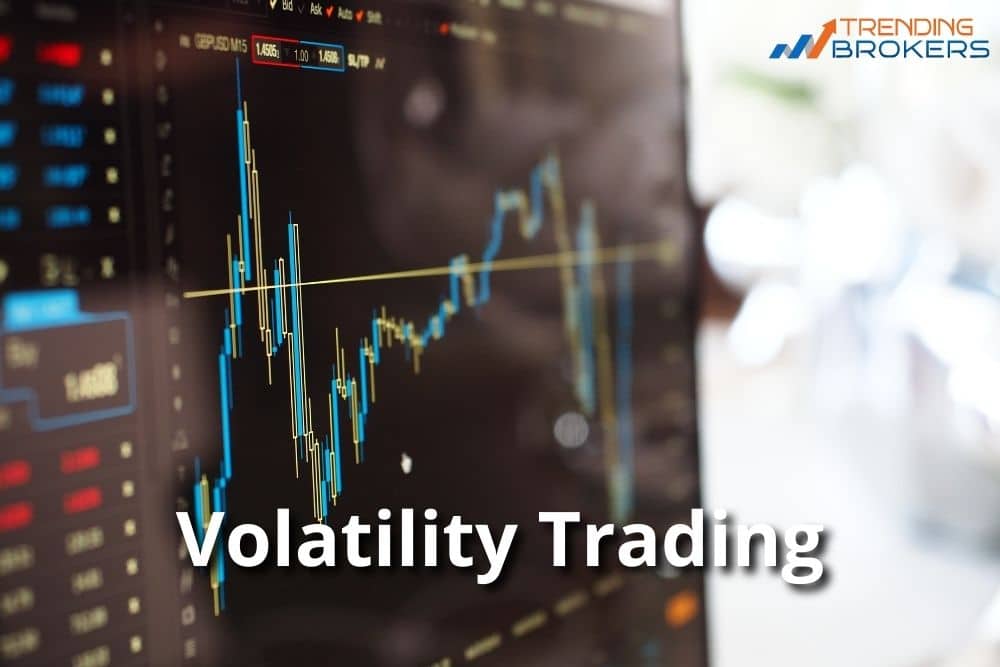When the trading market is moving quickly, it provides ample opportunities for traders. It makes trading better and exciting if a trader can predict the movement. However, if you want to find a comparatively easy way for earning profits, welcome to volatility trading. The volatile market produces opportunities for investors and traders for bidding and exiting. So, if a market player misses a chance, there are several more in the line per session to invest and divest as per the potential.
What is volatility?
Volatility is a standard measure of price or rate change of any financial instrument or product in a specified time. The volatility in the market means the prices of different assets are changing or moving quickly in a short duration. On the other hand, non-volatile markets do not see much change in the rates of assets.
The price change also depends on the number of volumes of buyers and sellers. A non-volatile asset may have either of the two. Thus, their price hardly shifts.
Also, day traders prefer volatile instruments for making quick gains and receiving multiple chances for correcting their errors. Scalping is one of the strategies that go well with volatile trading.
Any trading asset that experiences shifts in its prices is volatile. In volatility trading, a trader trades a financial instrument’s volatility instead of the price change. While trading in the volatile market, a user considers the future’s stability of a financial instrument’s.
The volatility market is interesting when world events and incidents move erratically in any direction or spike and fall suddenly.
In the volatile market, traders are usually unsure about the outcome. A user anticipates a significant reaction from the collective sentiment of traders. However, it’s the position that ensures whether they earn profits or make losses. The forecast is the driving force here.
For any given market index or security, volatility works as a standard statistical measurement of a returns’ dispersion. As a result, experts believe that securities are riskier with higher volatility.
In-depth understanding of volatility trading
In the security market, massive swings adhere to volatility in either direction. For instance, when a stock observes simultaneous falls and rises in its price over 1 per cent in a sustained time is known as a volatile market.
The options market is considered conducive for it. While pricing the options contract, the volatility of an asset is the most crucial aspect.
There are long volatility and short volatility for traders as per their trading capacity. Both have distinct benefits and require an understanding of the financial market and conditions.
For measuring volatility, there are several ways, including option pricing models, beta coefficients, the standard deviation of returns etc. When the volatility is high, the value of security can be unfurled on a massive range of values. It means that the value of an asset can change in a short period dramatically and in any direction.
However, when the volatility is low or tends to be low, there’s no or less fluctuation in the market. The prices of an asset remain steady or unmoved.
What is the importance of volatility in the financial market?
The volatility in the market is a vehicle that drives investment or channelises the financial market. The large swings in prices produce opportunities of investment and profit-making for traders. However, it needs the placement of the right strategies for ensuring gains during the volatile market. Without volatility, there would be no potential for gains. Also, one should be cautious while investing during massive movements as that may cause losses.
Method to measure volatility
Volatility is measured through a standard deviation traditionally. It gauges the distance travelled or the highest range touched by the current price during trading, relative to the moving average. The volatility of financial markets is dependent on multiple factors, including news reports, earning reports and daily occurring events. Sometimes, political factors and the economic health of a country have a significant impact on the volatility of the market.
For instance, if a multinational company does not perform well, as per the financial report’s expectations of the mark. There can be huge fluctuations in the price of the stock in the negative direction. Similarly, if the reports are beyond expectations and positive, the market would rise incessantly. It makes for an investment opportunity. However, there’s no surety how long the duration would continue. So, traders should apply stop-losses during these times.
Interestingly, even the meetings of central banks regarding monetary policies can send markets in ziffi. There can be huge volatility and the one who predicts them survives and earns from the price changes. It requires the acknowledgement of the market and a vision to foresee the change. However, volatility trading strategies come with experience.
When the domestic currency takes a nosedive, and people hope for big corporates to boost their investments, the market witnesses volatility both ways. So, people have a chance to apply volatility trading strategies like scalping. Here, they can hold their assets for a short duration and exit positions. They can repeat that formula and accumulate good income at the day’s end.
Requirement of volatility indicators
Volatility indicators aid in vetting the periods of low volatility and high volatility in a specific financial market. For knowing the period of different volatilities for trading, investors can use several indicators for analysing.
There are certain indicators available in the market that can help in knowing when the volatility will be high or low.
Top volatility indicators for traders
- Donchian indicator: It is a renowned volatility indicator and one of the most useful for traders. It determines immense fluctuations in financial assets. The indicator is a resultant of moving average calculations that create three lines. These consist of three different bands; median band, lower band and upper band. The lower band represents the least price of the security over a certain time, usually four weeks. On the other hand, the upper band displays the peak price of the security. The area between lower and upper bands is known as the Donchian Channel.
- Bollinger bands: There are three types of bands in Bollinger bands; middle, lower and upper. The middle band is the bars moving average or of 20 days. The middle band’s -2 standard deviation represents the lower band, while middle band’s +2 deviation represents the upper band. Interestingly, when the volatility slips, these bands contract and when the market surges, these bands expand.
- Average true range: It is also known as ATR. It maps price bars’ particular number’s range. However, it does not exhibit a trend to users always, it purely measures the volatility of the market. During a crucial news event and a choppy market, there’s a possibility of price movement occurring. If you can observe a change or an indication of that in the market, use ATR. It works in favour of investors. A hike in ATR indicates an increase in volatility. On the other side, ATR’s low reading indicates uneventful trading or no trading.
- Keltner Channel: It is an indicator based on volatility which is generally located at either side of a stock’s price. It helps in acknowledging a trend’s direction. It uses AR with breaks below or above the bottom and top barriers that signal a trend’s continuation. The middle line between it is EMA (exponential moving average). Notably, the upper band is twice the Average true range. However, the lower band is set 2 times lower than the ATR.
- Relative Volatility Index: It is also called RVI, and it analyses the volatility and direction of price. When the indicator goes below the level of 50, it is known as volatility on the downside, and when it’s above 50, the volatility is on the upside. Thus, traders can predict when to sell and buy assets. When the signal is above 50, it makes for the buying prospects and when it goes below 50, it means selling.
How to calculate the volatility?
Volatility is usually calculated by standard deviation and variance. The square root of variance is the standard deviation. Another way of calculating the volatility is VIX or volatility index. It was created by CBOE (Chicago Board Options Exchange). It helped in gauging the US stock market’s volatility for 30 days. It helps in gauging the futures bets for investors in the stock market. The high reading on the VIX exhibits the risky market.
Volatility arises from daily trading activities. Using models like binomial tree and Black-Scholes, volatility is utilised to price options contracts. The bigger volatility in underlying assets would translate into massive options premiums. There is immense possibility with volatility that on expiration the options will end up with funds.
Difference between historical volatility and implied volatility
Historical volatility is also known as statistical volatility. It vets the volatility of underlying assets. It measures the change in price over a predetermined duration of time. However, the metric is less prevalent compared to the implied volatility. The security’s price moves more than usual during the rise in historical volatility.
Implied volatility is also referred to as projected volatility. For options traders, it is like elixir, one of the most important metrics. It aids in knowing how volatile the market may be in the future. Thus, traders can calculate volatility using it. However, it is not an indicator of the market’s behaviour. There’s no forecast. It emerges from the price of an option itself. It provides future’s volatility expectations. The implied volatility helps in estimating the option market’s potential. It is the best option strategy for high volatility trading.
Quantitative volatility trading
This type of volatility uses algorithms and computer programs for exploiting volatility changes. Through the usage of software, strategies can be applied for the tiniest timeframes. Moreover, better trades can be taken, which are not possible for humans. FOr instance, a computer has the capacity of placing bids in milliseconds. So, for tiny profits, hundreds and thousands of bids can be placed by the software. It can be done using a variety of volatility trading strategies.
Trade low volatility
Trading low volatility is an art because it does not please every trader or investor in the market. Several long-term investors do not feel appealed by it, and they prefer markets remaining quiet. However, day traders are up for low volatility for earning decent returns. There are several buying and selling opportunities and within the range of traders because high volatility also amounts to risk compared to the low. So, the risk is moderate here.
The buyers get the opportunity to buy at low and sell higher the entire day. Scalping is the preferred choice here.
What causes volatility?
The major reasons for driving forces behind volatility are sentiments of investors and imbalanced supply and demand in the financial markets. They can find influences from economic crises, major developments in the international market, some exciting news or interesting developments.
Conclusion:
Trading in the volatile market is akin to earning profits, provided the strategies applied by traders are on point. Brokers like TradedWell, ROinvesting help in making the most of the volatile market. They offer several tools that help in discovering the best ways of volatility trading. There are different methods of finding volatility, some of them include technical analysis and conditions, price changes and price levels.
Technical indicators like ATR (Average true range) are useful in it.


